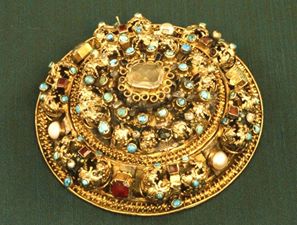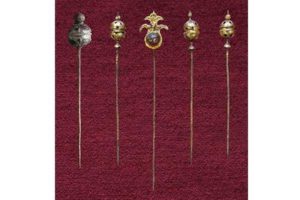A clasp from Transylvania

Transylvanian art in the 17th century: a clasp from the British Museum.
These huge round brooches, worn as clasps or as pendants, were characteristic of women’s dress in Transylvanian Saxony in the 17th and 18th centuries. They were known as Heftel (or Hefftlenn in old Transylvanian Saxon dialect), and were made in the workshops of the Transylvanian Saxon cities: Hermannstadt (Sibiu, Nagyszeben), or Kronstadt (Braşov, Brassó), also possibly Bistritz (Bistriţa, Beszterce), Mediasch (Mediaş, Medgyes), or Schäßburg (Sighişoara, Segesvár). You can read more about the Transylvanian German Saxons here:
https://www.hungarianottomanwars.com/essays/who-were-the-german-saxons-in-transylvania/
Description:
Silver-gilt clasp (‘Heftel’), built up in several layers to form a domed shape with a central flower formed of an octagonal colorless stone with looped milled wire surrounded within blue enameled silver petals, a gold star at the end of each petal, the enamel partly missing. The central flower is surrounded by two rings of turquoise, red, and colorless stones, and small pearls alternating with domed openwork foliate bosses and enameled plaques. Between the two rings and at the outer edge are ropework borders formed of twisted wire incorporating a thinner sheet of zigzag wire that protrudes from the rope. The three large pearls in collect settings around the outer edge are later additions; the central colorless stone may also be a replacement. The small enamel plaques inserted between the floral elements and the bands that hold the stones are enameled dark blue with yellow dots and gold stars, but much of the enamel is lost. The back is concave with rivets and a hinged silver pin.
A silver belt from Transylvania, end of the 17th century

This belt consists of eighteen hinged segments and a larger rectangular section with a round plaque in the center. Additional jewelry or silk tassel ornaments were once suspended from the three attached loops. The various colors of the semiprecious stones and the traces of enamel are reminiscent of sumptuous and exotic Ottoman-inspired designs. At the same time, several details evoke early Medieval–Romanesque– goldsmith work, such as reliquaries from northern Europe that survived at least until the early sixteenth century.

Medium: Gilded silver, beryls, garnets; Dimensions: Overall: 30 1/8 in. (76.5 cm) It can be found in New York., in The Metropolitan Museum of Art. “Hungarian Treasure: Silver from the Nicolas M. Salgo Collection,”.
A Hungarian Belt Buckle, 16th century

The snake-shaped hook at the left of this buckle would have engaged with a nearly identical one at the other end of the belt, possibly with the aid of a short chain-linked element. The intricately pierced openwork on this belt buckle demonstrates how a discerning patron would ensure his rank was reflected in each and every detail of his stylish costume. The number inscribed in ink on the back is evidence that this buckle was once in the Andrássy Treasury.

Medium: Silver, partly gilded, pearls, rubies; Dimensions: Overall: 9 1/8 in. (23.2 cm) It is in the Metropolitan Museum of Art in New York City but presently it is not in view.
Hungarian rings from the 15th-16th and the 17th centuries
The so-called “Matthias rings” are perhaps the most beautiful of them. They are on display in Budapest, Hungary, in the Museum of Applied Arts.
These rings are from the Hungarian aristocrat, Esterházy’s collection, from Fraknó Castle (now Burg Forchtenstein, Austria). They were allegedly made at the end of the 16th century. Their material is gold and enamel, and they are adorned with diamonds.

In the age of the Renaissance, such diamonds were shaped by splitting a regular octahedron into two, then the sides were polished. This was how they got these typical pyramid-shaped diamonds. These kinds of pointed diamonds were frequently used for engagement purposes as they used to symbolize constancy and adherence, and they have been quite popular for a long time. We can find such a ring in the Coat of Arms of the Medici family. However, these diamonds were rarely built into rings, so these finely detailed precious Matthias rings are quite uncommon.

No wonder they are associated with several monarchs. According to contemporary sources, King Matthias Corvinus of Hungary (ruled 1458-1490) was told to have received a large diamond ring from his fiancé, Beatrix of Aragon (1457-1508) in 1476 when they met for the first time. The theory that these rings were the engagement rings of Matthias and Beatrix, was quite widespread at the beginning of the 20th century.

Other historians doubt it because they say that these rings were found in the Esterházy family’s treasury and there was no such information attached to the rings’ description in the registry. They claim that the Matthias tradition should have been written somewhere in the registry. To me, it is a rather weak explanation.
The first description of the rings was made in 1645. Some researchers rule out the possibility that they could be made in Matthias’ age but it is likely that the rings may have belonged to a treasury of a monarch. As there are many questions about these rings, I incorporated them into my historical fiction novel called „The Ring of Kékkő Castle”. In this book, I try to entertain my readers while telling them about the life of the Valiant Order of the Hungarian Borderland in the first part of the 17th century. Here are my books:
Here are a few other rings from the 16th century:


The next ring is from the 17th century, its material is of diamond and gold, created by the champlevé enamel technique. Its diameter is2 cm and it weighs 4,8 grams:


This ring is also of the same age, made with a similar technique:

Engagement rings from Transylvania, cc 1600:

Materials: gold (22 karats) Techniques: cast; champlevé enamel; engraved decoration. Dimensions: diameter: 2,5 cm, weight: 7,10 gram

The ring was originally round but it has been cut into two in a vertical turned line the two separate pieces can be screwed together and can perfectly fit into each other at a certain point. Both pieces have a hand decoration when screwing the rings together, and the hands clasp.

The enameled majuscule inscriptions of the pieces read as follows: PETKI JANOS – KORNIS RATA, and CORDE CONIVNCTIVIVAMUS. This type of ring was extremely popular in Central Europe, and therefore, a great many similar pieces survived in various collections, such as the one in the Victoria and Albert Museum in London, dated 1650.

Source: mainly from Hagyomány és Múltidéző adatbázis, and Museum of Applied Arts, Budapest
The next rings can be found in the Museum of Applied Arts, too:


This signet ring was made in the 16th-17th century in Hungary:


Hairpins
These hairpins are from the cemetery of Dunaújváros, Hungary, end of the 16th century.
 It is a gown pin from the cemetery of Igar, Fejér County, Hungary from the end of the 16th century:
It is a gown pin from the cemetery of Igar, Fejér County, Hungary from the end of the 16th century:

Earrings
These earrings are decorated with ruby and gold, early 17th century, displayed in Hungary, Applied Art Museum:

Medals and Pendants
This clock medal is from the first part of the 17th century, it was made in Germany. This one is from the treasury of Fraknó castle, its owner must have been a wealthy Hungarian noblelady. Now, it is on display in the Museum of Applied Arts, Hungary.

A Pendant depicting Diana, 16th century, Hungary
Diana is depicted with a lute and a deer, formed of ronde-bosse enamel, in a pierced cartouche. The border follows the jewel plans made by Daniel Mignot in the mid-16th century which were very popular all around Central Europe. The dominant colors of the enamel are white, green, blue, and red.

There is a similar pendant made in the Netherlands in the 16th century, now in the collection of the Victoria and Albert Museum in London. Dimensions: height: 7,3 cm, width: 4,5 cm, weight: 19,9 g. (Museum of Applied Arts, Budapest)
A Pendant, the second half of the 16th century, Transylvania


Dimensions: height: 6,3 cm, width: 4,6 cm, weight: 22 g, (Museum of Applied Arts, Budapest)
A Statuette, late 17th century, Hungary

A Pendant (1600-1630) German or Hungarian

Dimensions: height: 6cm, width: 3.5 cm, weight: 16,1 g (Museum of Applied Arts)
Pendant – engagement pendant of Bethlen Gábor, ruler of Transylvania, and Catherine of Brandenburg (17th century, Transylvanian
The center of the jewel is formed by a shield-like heart with red enamel, framed by diamonds and rubies, and supported on each side by a hand with a ring on the index finger. The hands holding the heart and the pair of doves were frequent elements of engagement presents, and thus make clear the intended function of this jewel as well. The sacral symbols present on the pendant (anchor, cross, snake, etc.), however, were not common on such pieces and must refer to the deep religious commitment of the owner-couple.

At the 1884 exhibition of goldsmith works held in Budapest, scholars and the public had an opportunity to study five similar pieces. (This was the first and so far the last occasion when the five jewels were all on display together.) The catalog of the exhibition states that “according to tradition, at the wedding of Prince Bethlen Gábor and Catherine of Brandenburg, six pages and the prince himself wore such pendants. The jewels of the pages were made of silver while that of the prince was made of gold”.

The peculiar jewel is made of silver, which explains its somewhat modest technical execution, although it is also gilt and decorated with numerous precious stones and enamel. According to the latest research, this pendant was used as an ephemeral jewel at the 1626 wedding of the Prince of Transylvania, Bethlen Gábor, which was held at Kassa (today Košice, Slovakia). It was probably worn by one member of the close retinue of the ruler, while its companion pieces in gold were worn by the princely couple. Similar works are preserved in Dresden, Brussels, and also in the Hungarian National Museum.
Dimensions: height: 9,4 cm, width: 7,5 cm. (Museum of Applied Arts, Budapest)
A Medal made of Hungarian Opal (around 1600)

Measures: 3.4 cm, 83.81 g, 7.9 cm
It is on display in the Kunsthistorisches Museum Wien, Hofjagd- und Rüstkammer, Austria.
A gilded copper crucifix clock, 1693, Hungary
We can see this text on it: „Me fecit Adamus Bachmedjei A. D. 1693”. It is in the Hungarian National Museum in Budapest. It was created by Master Ádám from Bács County.

These kinds of crucifix clocks were in fashion in the 16th and 17th centuries in Europe. The clock was built into the lower part and the time was displayed on the top: a fixed arm pointed at the turning Latin numbers.
Dear Readers, I can only make this content available through small donations or by selling my books or T-shirts.
If you like my writings, please feel free to support me with a coffee here:
You can check out my books on Amazon or Draft2Digital, they are available in hardcover, paperback, or ebook:
https://www.amazon.com/dp/198020490X
or at https://books2read.com/b/boYd81


My work can also be followed and supported on Patreon: Become a Patron!http://Become a Patron!





